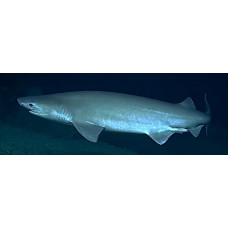Latin name
Hexanchus griseus
Other names
Сow shark
Identification
The bluntnose sixgill shark has a dense, spindle-shaped body and a broad head with a blunt muzzle. The eyes are small with fluorescent blue-green pupils. The wide mouth is rounded in the shape of an arch. There are 6 rows of teeth in the lower jaw and 4 rows in the upper jaw on either side of the symphysis. The lower teeth are broad, comb-like, the upper teeth end in a central spearhead. Caudal stem short and thick. Dermal denticles are loosely arranged, rounded with a central ridge and three protuberances.
Features of fish fins
The small dorsal fin is displaced towards the tail. The spine at the base is absent. The anal fin is smaller than the dorsal fin. The pectoral fins are small and rounded. There is a ventral notch on the edge of the upper blade of the caudal fin. The upper lobe of the caudal fin is long, especially in juveniles, while the lower lobe is fairly well developed.
Fish colouring
Colour ranges from tan and black-grey to chocolate brown, with a whitish belly. Some individuals have a pale stripe on the lateral line. There may be dark spots on the sides.
Distribution
These sharks inhabit the temperate, subtropical and tropical waters of all the world's oceans. In the western Atlantic thay are found from North Carolina to Florida, USA, in the northern Gulf of Mexico, off the coast of Cuba, Nicaragua, Costa Rica, Venezuela, southern Brazil and northern Argentina. In the eastern Atlantic, it is found from Iceland and Norway to Senegal, Nigeria, Angola, Namibia, in the Mediterranean, in the Black Sea off Turkey and possibly off the Ivory Coast. In the Indian Ocean these sharks are found off the coasts of South Africa, Mozambique (south), Madagascar, the Aldabra Islands and the Comoros Islands. In the western Pacific, they are found off Japan (east), Taiwan, Malaysia, Sumatra, Australia (New South Wales and Victoria) and New Zealand. In the central Pacific they are found in Hawaii and Palau. In the eastern Pacific, they inhabit waters from the Aleutian Islands to Baja California and Chile.
Habitat
It is a bottom dwelling, coastal and pelagic species. Sharks are found on continental and island shelves and in the upper part of the continental slope from the surface to depths of 2500m. Juveniles prefer shallow waters close to the shore, adults are found deeper than 91 m. In tropical waters they rarely approach the shore.
Size
The maximum recorded length is 5.4 m. The average length of males is between 309 and 330 cm. Females are larger, with an average length of 350 to 420 cm. Maximum recorded weight is 590 kg.
Behavior
They make daily vertical migrations, resting on the bottom during the day and rising to the surface in the evening.
They are rather slow, but can develop great speed in pursuit of prey.
They react strongly to light of even medium intensity, indicating an increased sensitivity to light.
Once caught, adult sharks behave sluggishly, while juveniles actively resist capture.
Food and feeding habits
Their large size and wide range make the diet of these sharks very varied. They eat crustaceans, cephalopods, myxinidae, bony fish (coryphaena, small swordfish, marlin, herring, sargans, codfish, sea pike, hake, flounder, sea roosterfish, anglerfish) and cartilaginous fish, including congeners. These sharks have been known to stalk hooked tribesmen and rise to the surface after them. They also hunt rays and other sharks (spiny dogfish, longnose spurdog, shortnose spurdog, prickly shark), eat carrion and have even been known to attack seals. Their lower teeth allow them to saw through large prey.
Reproduction
Reproduction by oviparity. Embryos enclosed in egg capsules develop in the mother's body. A litter contains 22 to 108 pups, 65-70 cm long. Births occur on the outer edge of the continental shelf and on the upper part of the continental slope. Females reach maturity at 450-482 cm and males at 315 cm.
Fishing
Commercially fished and popular with recreational anglers.
Relationship with a person
This species of shark is considered safe for humans as no unprovoked attacks have been recorded.
| Classification | |
| Phylum | Chordata |
| Class | Chondrichthyes |
| Squad | Hexanchiformes |
| Family | Hexanchidae |
| Genus | Hexanchus |
| Species | H. griseus |
| Features | |
| Conservation status | Near Threatened |
| Habitat | Pelagic |
| Life span, years | No information |
| Maximum body weight, kg | 590 |
| Maximum length, cm | 540 |
| Sailing speed, m/s | No information |
| Threat to people | Edible |
| Way of eating | Predator |
Bluntnose sixgill shark
Tags: bluntnose sixgill shark



